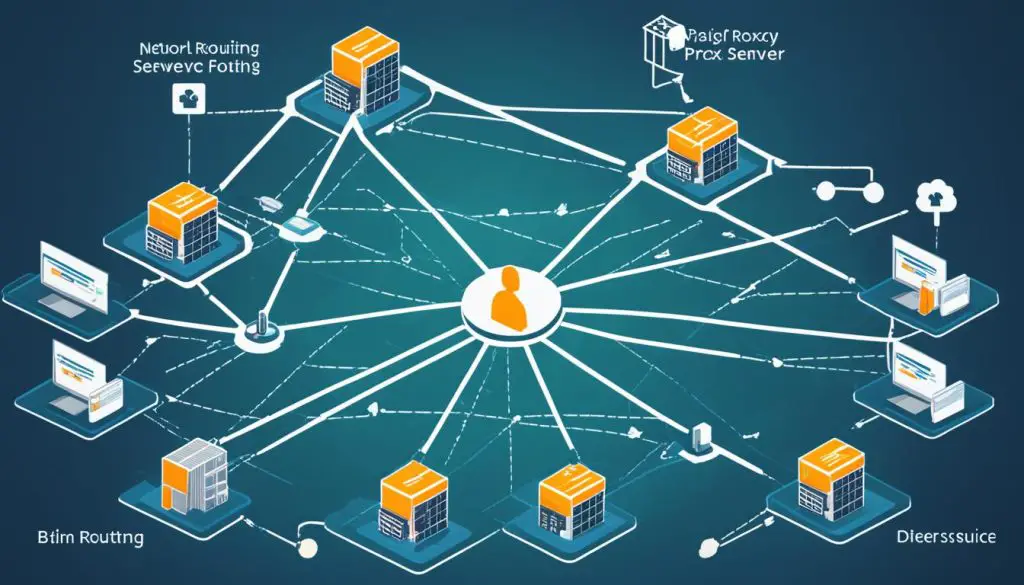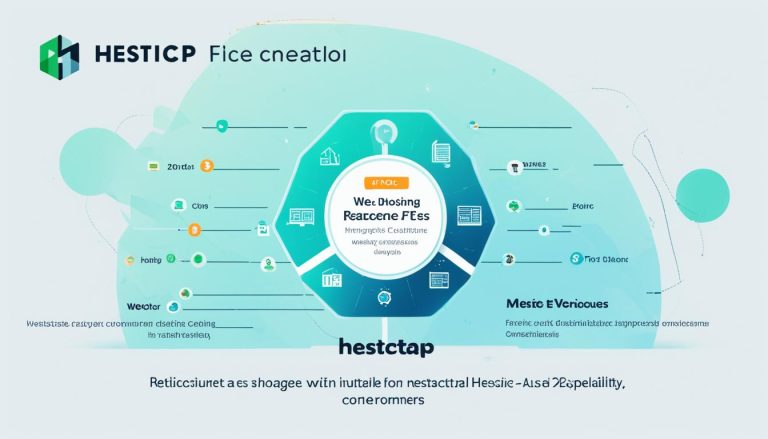Exploring What is a Reverse Proxy: An Overview
A reverse proxy is an essential component of modern network architecture that plays a crucial role in directing client requests to the appropriate backend servers. By sitting behind a firewall in a private network, the reverse proxy provides an additional level of security and control in network traffic. It acts as a mediator between clients and servers, ensuring efficient distribution of client requests and maximizing performance.
Commonly used for load balancing, web acceleration, and security and anonymity, a reverse proxy offers numerous benefits. It can distribute client requests across multiple servers, balance the load to prevent overloading, and accelerate web traffic by compressing data and caching commonly requested content. Furthermore, a reverse proxy enhances security by protecting server identities, defending against attacks, and encrypting SSL requests. It offers a single access point for multiple servers, simplifying URL structures and improving network management.
Key Takeaways:
- A reverse proxy sits behind a firewall and directs client requests to the appropriate backend servers.
- It enhances security, load balancing, and web acceleration.
- NGINX Plus and NGINX Open Source are popular reverse proxy solutions used by high-traffic websites.
What is a Reverse Proxy and How Does It Work?
A reverse proxy acts as a mediator between clients and servers, forwarding client requests to backend servers. It plays a vital role in optimizing network traffic flow and improving overall system performance.
When a client sends a request to access a website, it reaches the reverse proxy first. The reverse proxy then evaluates the request and determines the appropriate backend server to handle it. By distributing client requests across multiple servers, a reverse proxy balances the load, preventing any single server from becoming overwhelmed.
One of the key benefits of using a reverse proxy is its ability to accelerate web traffic. Through techniques like data compression and content caching, a reverse proxy optimizes the delivery of web content. Frequently requested resources are stored in cache, allowing the reverse proxy to serve them quickly without the need to pass the request to the backend server. This results in faster response times, reduced bandwidth usage, and improved user experience.
In terms of security, a reverse proxy can significantly enhance server protection. It acts as a shield, allowing only authorized requests to pass through to the backend servers. The reverse proxy can also encrypt SSL requests, ensuring secure transmission of sensitive data. By safeguarding server identities, a reverse proxy defends against various types of attacks, such as Distributed Denial of Service (DDoS) attacks and SQL injections.
ngrok, an advanced reverse proxy tool, is widely used for development and testing purposes. It provides secure access to localhost servers behind NATs and firewalls, allowing developers to test their applications in real-world scenarios.
In summary, a reverse proxy is a crucial component in modern network infrastructure. It efficiently manages client requests, balances the load, accelerates web traffic, and strengthens security. By configuring a reverse proxy system, businesses can optimize their network performance and ensure a reliable and secure web presence.
Benefits of Using a Reverse Proxy
The use of a reverse proxy provides several benefits. It enables load balancing, ensuring that client requests are efficiently distributed among servers to prevent overloading. This improves performance and reliability.
Reverse proxies can also enhance security by intercepting requests and protecting backend server identities. They can encrypt SSL requests and offload the encryption process from the servers.
Using a reverse proxy adds an extra layer of protection by shielding the internal servers from direct exposure to the internet. It acts as a gatekeeper, filtering out malicious requests and defending against potential cyber attacks.
Additionally, reverse proxies offer a single access point for multiple servers, simplifying URL structures and improving network management. They act as an intermediary, routing client requests to the appropriate backend server based on predefined rules.
Benefits of Using a Reverse Proxy:
- Load balancing to improve performance and reliability.
- Enhanced security by protecting backend server identities and defending against attacks.
- SSL request encryption and offloading for improved server performance.
- Simplified URL structures and improved network management.
| Benefits of Using a Reverse Proxy | Explanation |
|---|---|
| Load Balancing | Ensures efficient distribution of client requests among servers, preventing overloading and improving performance and reliability. |
| Enhanced Security | Intercepts requests, protects backend server identities, encrypts SSL requests, and defends against cyber attacks. |
| Improved Performance | Offloads SSL request encryption from the servers, optimizing server resources. |
| Streamlined Network Management | Offers a single access point for multiple servers, simplifying URL structures and improving network management. |
Examples of Reverse Proxy Implementation
When it comes to implementing reverse proxies, many high-traffic websites rely on trusted solutions to optimize their infrastructure. Let’s take a look at some prominent examples of companies that utilize reverse proxies for their network architecture:
-
Dropbox
Dropbox, a popular cloud storage and file sharing service, utilizes NGINX Plus as their reverse proxy solution. By leveraging NGINX Plus, Dropbox is able to balance the load, accelerate web traffic, and enhance security.
-
Netflix
Netflix, the leading global streaming platform, relies on NGINX Open Source as their reverse proxy solution. NGINX Open Source enables Netflix to efficiently distribute client requests among servers, ensuring a seamless streaming experience for millions of users.
-
Zynga
Zynga, a renowned game development company, employs NGINX Plus as their reverse proxy solution. By leveraging NGINX Plus, Zynga is able to balance the load during peak gaming times, ensuring smooth gameplay and an enjoyable user experience.
These are just a few examples of how companies benefit from reverse proxy implementations. In each case, NGINX Plus and NGINX Open Source play a crucial role in optimizing network traffic flow, enhancing security, and improving overall performance.

Implementing a Reverse Proxy
Implementing a reverse proxy is a crucial task for network administrators. To configure a reverse proxy, the specific steps may vary depending on the chosen software, such as Nginx, Apache, or HAProxy. Let me walk you through the general process:
- Select the appropriate reverse proxy software – Depending on your requirements and infrastructure, choose a reverse proxy solution that aligns with your needs. Popular options include Nginx, Apache, and HAProxy.
- Configure the reverse proxy server – Once the software is chosen, set up the reverse proxy server. This involves defining rules and settings that govern the routing of client requests to the backend servers. These rules determine which requests are redirected and how they are distributed among the servers.
- Establish backend server connections – Connect the reverse proxy server to the backend servers that will handle the client requests. This requires specifying the IP addresses or domain names of the backend servers and configuring the necessary communication protocols, such as HTTP or HTTPS.
- Test and troubleshoot – After the initial configuration, it is essential to thoroughly test the reverse proxy setup. Verify that client requests are properly routed to the backend servers, monitor the load balancing functionality, and ensure the expected security measures are in place. If any issues arise, troubleshoot them accordingly.
By implementing a reverse proxy, network administrators can effectively manage the flow of network traffic and make use of features such as load balancing, security, and improved performance.
“Implementing a reverse proxy involves selecting the right software, configuring the server, establishing backend connections, and conducting thorough testing.”
Reverse Proxy Configuration Example:
Here is an example of how a reverse proxy configuration could look using Nginx:
| Reverse Proxy Configuration Steps | Example |
|---|---|
| Define the backend servers | server {
listen 80; server_name example.com; location / { proxy_pass http://backend-server; } } |
| Specify routing rules | upstream backend-server {
server backend1.example.com; server backend2.example.com; server backend3.example.com; } |
Conclusion
In conclusion, a reverse proxy plays a crucial role in modern network architecture, offering significant benefits to businesses. It contributes to load balancing by efficiently distributing client requests across multiple backend servers, ensuring optimal performance and preventing overloading. Additionally, a reverse proxy enhances security by intercepting requests and protecting the identities of backend servers, thereby safeguarding sensitive data.
Moreover, reverse proxies offer improved performance by accelerating web traffic through data compression and caching commonly requested content. This caching mechanism reduces response times and enhances the overall user experience. NGINX Plus and NGINX Open Source are widely recognized as reliable reverse proxy solutions used by major websites such as Dropbox, Netflix, and Zynga.
For individuals working in the field of information technology, understanding the role and functionality of a reverse proxy is imperative. By leveraging the benefits of a reverse proxy, businesses can optimize their network traffic flow, ensure a secure web presence, and provide a seamless user experience. Implementing a reverse proxy, whether it’s NGINX or other popular solutions, allows organizations to achieve efficient load balancing, robust security, and improved performance, making it an indispensable component of their network infrastructure.
FAQ
What is a reverse proxy?
A reverse proxy is a type of proxy server that sits behind a firewall in a private network and directs client requests to the appropriate backend server.
How does a reverse proxy work?
A reverse proxy acts as a mediator between clients and servers, forwarding client requests to backend servers. It can distribute client requests across multiple servers, balancing the load and maximizing performance.
What are the benefits of using a reverse proxy?
Using a reverse proxy provides several benefits, such as load balancing, enhancing security, and improving performance. It ensures efficient distribution of client requests, protects backend server identities, and simplifies URL structures.
Can you provide examples of reverse proxy implementation?
Sure! Dropbox, Netflix, and Zynga are examples of companies that use NGINX Plus and NGINX Open Source as their reverse proxy solutions.
How can a reverse proxy be implemented?
Network administrators are responsible for implementing a reverse proxy. The specific steps for configuration can vary depending on the chosen reverse proxy software, such as Nginx, Apache, or HAProxy.
What is the importance of a reverse proxy?
A reverse proxy is a crucial component of modern network architecture. It helps in load balancing, enhancing security, and improving performance, ultimately optimizing network traffic flow and ensuring a secure and efficient web presence.
Source Links
- About the Author
- Latest Posts
Janina is a technical editor at Text-Center.com and loves to write about computer technology and latest trends in information technology. She also works for Biteno.com.






